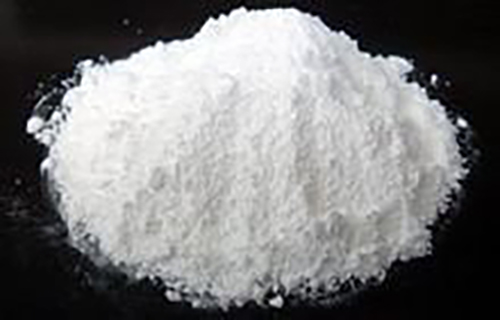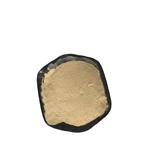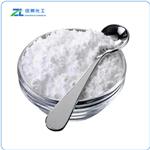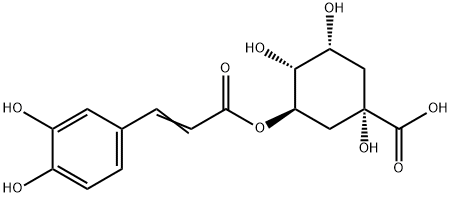The effects of chlorogenic acid
Mar 30,2022
Introduction
Chlorogenic acid is an organic compound with the chemical formula C16H18O9, which is one of the main antibacterial and antiviral active pharmacological components of honeysuckle[1]. The hemihydrate of chlorogenic acid is needle crystal (water). 110 ℃ into anhydrous compound. The solubility in water at 25°C is 4%, and the solubility in hot water is greater. Chlorogenic acid is easily soluble in ethanol and acetone, and very slightly soluble in ethyl acetate. Chlorogenic acid has a broad antibacterial effect, but can be inactivated by protein in vivo. Chlorogenic acid is similar to caffeic acid and can increase the central excitability of rats when administered orally or intraperitoneally. Chlorogenic acid can increase intestinal peristalsis and rat uterine tone in rats and mice. Chlorogenic acid has a choleretic effect and can increase bile secretion in rats. Chlorogenic acid has a sensitizing effect on people. After inhaling the plant dust containing this product, asthma and dermatitis may occur.

Picture 1 The appearance of chlorogenic acid
Chlorogenic acid has a wide range of biological activities, and modern scientific research on the biological activity of chlorogenic acid has gone deep into many fields such as food, health care, medicine and daily chemical industry. Chlorogenic acid is an important biologically active substance, which has the functions of antibacterial, antiviral, increasing white blood cells, protecting liver and gallbladder, antitumor, lowering blood pressure, lowering blood lipid, scavenging free radicals and exciting the central nervous system.
The structure of chlorogenic acid
Chlorogenic acid (hereinafter referred to as CA) is a depsidic acid generated by caffeic acid (Caffeic acid) and quinic acid (Quinic acid, 1-hydroxyhexahydrogallic acid). A phenylpropanoid compound produced via the shikimate pathway[2]. According to the different binding sites and numbers of caffeoyl on quinic acid, theoretically, there are 10 chlorogenic acid isomers composed of monocaffeoylquinic acid and dicaffeoylquinic acid, which are: 1 -Caffeoylquinic acid, 3-caffeoylquinic acid, 4-caffeoylquinic acid, 5-caffeoylquinic acid, 1,3-dicaffeoylquinic acid, 1,4-dicaffeoylquinic acid Niacinic acid, 1,5-dicaffeoylquinic acid, 3,4-dicaffeoylquinic acid, 3,5-dicaffeoylquinic acid, 4,5-dicaffeoylquinic acid. The chlorogenic acid isomers found in plants are as follows: chlorogenic acid (3-caffeoylquinic acid), cryptochlorogenic acid (Band510) (4-caffeoylquinic acid), neochlorogenic acid (5-caffeoylquinic acid) Caffeoylquinic acid), isochlorogenic acid A (3,5-dicaffeoylquinic acid), isochlorogenic acid B (3,4-dicaffeoylquinic acid), isochlorogenic acid C (4 ,5-dicaffeoylquinic acid), lytherin (1,3-dicaffeoylquinic acid).
Antibacterial and antiviral effects
Eucommia chlorogenic acid has strong antibacterial and anti-inflammatory effects, aucubin and its polymers have obvious antibacterial effects, and aucubin has inhibitory effects on Gram-negative and positive bacteria[3]. Acupuncture has antibacterial and diuretic effects, and can promote wound healing; acupuncture and glucoside can also have obvious antiviral effects after pre-culture, but it does not have antiviral functions by itself. Research by the Institute of Advanced Medicine, Aichi Medical University, Japan has confirmed that the alkaline substances extracted from Eucommia ulmoides have the function of resisting viruses that destroy the human immune system. This substance may be used to prevent and treat AIDS.
Anti-oxidize effect
Chlorogenic acid is an effective phenolic antioxidant with stronger antioxidant capacity than caffeic acid, p-hydroxybenzoic acid, ferulic acid, syringic acid, butylated hydroxyanisole (BHA) and tocopherol. The reason why chlorogenic acid has antioxidant effect is because it contains a certain amount of R-OH groups, which can form hydrogen free radicals with antioxidant effect to eliminate the activity of free radicals such as hydroxyl free radicals and superoxide anions, thereby protecting Tissue is protected from oxidative damage.
Free radical scavenging, anti-aging, anti-musculoskeletal aging
Chlorogenic acid and its derivatives have stronger free radical scavenging effects than ascorbic acid, caffeic acid and tocopherol (vitamin E), can effectively scavenge DPPH free radicals, hydroxyl free radicals and superoxide anion free radicals, and can also inhibit low density Oxidation of lipoproteins. Chlorogenic acid plays an important role in effectively scavenging free radicals in the body, maintaining the normal structure and function of body cells, preventing and delaying the occurrence of tumor mutation and aging. Eucommia chlorogenic acid contains a special ingredient that can promote the synthesis and decomposition of collagen in human skin, bones and muscles. It has the functions of promoting metabolism and preventing decline. It can be used to prevent astronauts from space weightlessness caused by bones and muscles. At the same time, it was found that Eucommia chlorogenic acid has obvious anti-free radical effect both in vivo and in vitro.
Mutation suppression and anti-tumor
Modern pharmacological experiments have proved that chlorogenic acid of Eucommia ulmoides has anti-cancer and anti-tumor effects. Japanese scholars have studied the antimutagenicity of chlorogenic acid of Eucommia ulmoides, and found that this effect is related to antimutagenicity components such as chlorogenic acid. The significance of chlorogenic acid for tumor prevention was revealed.
Polyphenols such as chlorogenic acid and caffeic acid in vegetables and fruits can inhibit the mutagenicity of carcinogens aflatoxin B1 and benzo[a]-pyrene by inhibiting activating enzymes; chlorogenic acid can also reduce carcinogenicity by reducing carcinogenicity. The utilization rate of the substance and its transportation in the liver can achieve the effect of anti-cancer and anti-cancer. Chlorogenic acid has a significant inhibitory effect on colorectal cancer, liver cancer and laryngeal cancer, and is considered to be an effective chemoprotective agent for cancer.
Cardiovascular protection
As a free radical scavenger and antioxidant, chlorogenic acid has been proved by a large number of experiments that this biological activity of chlorogenic acid can produce a protective effect on the cardiovascular system. Isochlorogenic acid B has strong promotion in rats Pre-isochlorogenic acid B has strong promotion of prostaglandin (PGI2) release and antiplatelet aggregation in rats; antibodies induced to guinea pig lung fragments induce SRS-A The release inhibition rate was 62.3%. Isochlorogenic acid C also promotes the release of PGI2. In addition, isochlorogenic acid B has a strong inhibitory effect on platelet thromboxane biosynthesis and hydroperoxidation-induced endothelin damage.
Other biological activities
Because chlorogenic acid has a special inhibitory effect on hyaluronic acid (HAase) and glucose-6-phosphatase (Gl-6-Pase), chlorogenic acid is used for wound healing, healthy and moist skin, lubricating joints, preventing inflammation and The balance control of blood sugar in the body has certain curative effects. Chlorogenic acid also has strong inhibitory and killing effects on various diseases and viruses. Chlorogenic acid has pharmacological effects such as lowering blood pressure, antibacterial, antiviral, anti-inflammatory, increasing white blood cells, preventing diabetes, significantly increasing gastrointestinal motility and promoting gastric secretion, and has obvious curative effect on acute throat inflammation. Studies have shown that oral chlorogenic acid can significantly stimulate the secretion of bile, and has the effect of choleretic and liver protection; it can also effectively inhibit the hemolysis of rat erythrocytes caused by H2O2.
Reference
1 Zhang Anling, Ma Qiong. Chlorogenic acid and its analogs and biological activity, 2001
2 Wu Weihua, Kang Zhen, Ouyang Dongsheng, etc. Progress in Pharmacological Research of Chlorogenic Acid, 2006
3 Hu Zongfu, Yu Wenli, Zhao Yaping. Chlorogenic acid scavenging reactive oxygen species and anti-lipid peroxidation research, 2006
- Related articles
- Related Qustion
Chlorogenic acid
327-97-9You may like
Chlorogenic acid manufacturers
- Chlorogenic acid
-

- $6.00 / 1KG
- 2024-04-25
- CAS:327-97-9
- Min. Order: 1KG
- Purity: More than 99%
- Supply Ability: 2000KG/Month
- Chlorogenic Acid
-

- $15.00 / 1kg
- 2024-04-23
- CAS:327-97-9
- Min. Order: 1kg
- Purity: 99%
- Supply Ability: 5000kg/Week
- Chlorogenic acid
-

- $1.00 / 1g
- 2024-04-23
- CAS:327-97-9
- Min. Order: 1g
- Purity: 99%
- Supply Ability: 10 tons




